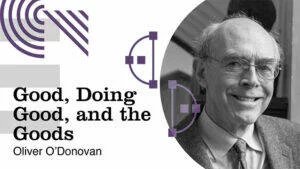I have major presuppositional differences from Schneider regarding Scripture and creation. Although I agree with him that theodicy is nothing without eschatology, I also believe that eschatology is nothing without protology. One cannot take the Bible seriously about the end, without taking it seriously about the beginning.
Schneider sees the happy ending of a new heavens and a new earth as a natural outgrowth of Christianity; but this does not hold water canonically if creation was not historically literal as portrayed in Genesis. I am a creationist who, for many Scriptural reasons, believes that the universe/matter/earth itself is quite old (I am even open to billions of years), but that life on earth is young (6,000– 10,000 years).For some of my reasons, see Richard M. Davidson, “The Biblical Account of Origins,” Journal of the Adventist Theological Society 14 (2003): 4–43. In addition, as a trained biologist (MA in Biology), there are multiple scientific considerations that also point me this way.For some of my reasons, see Leonard Brand and Arthur Chadwick, Faith, Reason, & Earth History: A Paradigm of Earth and Biological Origins by Intelligent Design (3rd ed.; Berrien Springs, MI: Andrews University Press, 2016).
Therefore, one might think I would seriously disagree with Schneider’s conclusions related to deep time and the weaving of the Darwinian theory into theism. However, I find myself agreeing with most of his main concerns regarding theism, which arise from the history of life on earth, whether long or short. For even if there have only been 6,000–10,000 years of animal suffering since the fall, God is still responsible for that. Even 6,000 years is deep enough time to be too much: “The causal agent of natural evil simply is God, and theists need to face this reality in unequivocal terms” (p. 239).
In addition, although I believe that God created a small number of original types of animals a few thousand years ago, which then evolved in a short time into the many different “worlds” mentioned by Schneider, the biblical concept of a global flood causing the fossil record still indicates a monumental amount of animal suffering and almost all lines going extinct. Indeed, the biblical account of a global flood puts the blame even more on God for having brought about the suffering of countless animals. The “anti-cosmic micro monsters” are also still utterly horrific, and God is responsible for allowing them. It is still the same “God who knowingly gave evolution the power to create” them (p. 160). The evils inscribed into the world of nature are a problem for theism in a short chronology as well, and do not let God off the hook even for young earth creationists.
Thus, despite our differing presuppositions regarding the biblical text, much of the force of Schneider’s book is still relevant for someone like myself who holds to a traditional Lapsarian theodicy and cosmic conflict model. Contra Schneider, I believe that the cosmic conflict metanarrative (referring to an ongoing controversy between God and Satan, which began in heaven with an angelic rebellion and fall) actually does address and answer the necessary conditions he raises.For a more detailed and updated view of the cosmic conflict model in relation to theodicy, see John Peckham, Theodicy of Love: Cosmic Conflict and the Problem of Evil (Grand Rapids, MI: Baker Academic, 2018). And yet, since sin leads to death according to the Bible, if Satan did indeed bring sin and suffering into the universe, putting the blame for sin ultimately on him, this means that death may have been already worked into the fabric of the universe in some way before human sin (including in the creation of life on earth, which seems to be a different outcome than Schneider assumes would be present with an angelic fall). As the ultimate Creator, the one who allowed Satan to work and humans to have free choice, God would still be responsible on some level.
Thus, similar to Schneider, I have long believed and seen in Scripture that at least some animals will be in heaven (although I see no indication in Scripture for a cosmic universalism as Schneider proposes), and that this is the way that God can defeat the undeserved evils they have suffered. However, I think there are a few of Schneider’s points in this regard that need to be reconsidered, specifically related to the canonical picture of non-human animals (nh-animals). I have written extensively about this in my dissertation, and will summarize some of the salient issues here.A. Rahel Schafer, “‘You, YHWH, Save Humans and Animals’: God’s Response to the Vocalized Needs of Non-Human Animals as Portrayed in the Old Testament,” Wheaton College PhD Diss., 2016. The Bible portrays nh-animals as more accountable for their actions, and more in relationship with God than Schneider sees. This biblical portrayal actually indicates some reasons for nh-animal suffering by highlighting their accountability in certain cases (all are not innocent), as well as indicating some reasons for their future redemption by highlighting their relationality and connection with God (many are innocent martyrs who can understand what is really happening).
Non-human Animals Are Accountable for Their Actions
Schneider states that it is “commonly assumed that animals have done nothing wrong” (p. 233), and characterizes those who do see their wrongdoing as supposing “rather absurdly that animals deserve to be punished for any ‘bad’ things they have done” (p. 235). And yet, the laws in the OT make it clear that nh-animals are responsible and accountable for at least some of their actions, and are to be punished accordingly.Schneider states that it is “commonly assumed that animals have done nothing wrong.” They are even held accountable for many of the same requirements as humans (e.g., not to touch Sinai [Exod 19:12-13], to avoid bestiality [Lev 20:16], not to kill humans [Gen 9:5–6; Exod 21:28], and to keep the Sabbath [Exod 20:8–11; 23:10–12]).
Genesis 1–11 also portrays nh-animals as implicated in sin, and accountable to God for their actions. In Genesis 3, God curses the snake itself with a literal punishment, even if there is also a supernatural being acting behind it.For support of a supernatural involvement with/behind the creature, see Afolarin Ojewole, “The Seed in Genesis 3:15: An Exegetical and Intertextual Study,” Andrews University PhD Diss., 2002. Genesis 6:11–12 states that “all flesh has corrupted itself on the earth,” using terminology that refers to all creatures not just humans. Non-human animals are also involved in the corruption along with humans, and in Genesis 6:13 God states that the whole earth is filled with violence and corruption.Among others, Cassuto argues that nh-animals are an active part of the corruption, and that they must have transgressed in order to be punished (A Commentary on the Book of Genesis [Part II]: From Noah to Abraham [trans. Israel Abrahams; Varda, 2012], 54). In Genesis 9:5, God holds all animals (human and non-human) responsible for the murder of humans. For this law to be just, it seems that all nh-animals must understand the immorality of such acts on some level.J. McKeown (Genesis, The Two Horizons Commentary [Grand Rapids, MI: Eerdmans, 2008], 64) argues that nh-animals must have a level of moral understanding in order to be held accountable here.
Many passages also portray nh-animals in a more favorable light than humans, as if they respond to their limited knowledge of God more correctly than sinful humans. For example, in Isaiah 43, nh-animals honor (kbd) God for his salvific action (v. 20), even when humans do not honor (kbd) him (v. 23). The prophets often portray nh-animals trembling before God along with humans (e.g., Jer 25:30; Ezek 38:20; Hos 11:10; Amos 1:2; 3:4). Job portrays all nh-animals as knowing God is sovereign, and able to teach this to humans (e.g., Job 12:7–10; 35:11; 36:33).
Although nh-animals must ultimately be innocent of sin, in order to take the place of humans and die as substitutionary sacrifices in Leviticus, nh-animal accountability seems to be the reason that the actions of the snake bring suffering on all nh-animals, like the actions of Adam and Eve bring suffering on all humans. Even though nh-animals are not ever described as sinning in Scripture, they are held accountable for their actions, and this seems to be at least one of the causes for their suffering.
Non-human Animals as Relational and Communicative
Schneider states that nh-animals have “limited nonhuman cognitive and meaning capacity” (p. 245), but the Bible portrays the opposite picture. Non-human animals are also in relationship with God, closely associated with humans, and even converse with humans and God. God commands them to multiply and fill the earth, implying that they have at least some legitimate right to the earth just as humans do. By eating plants and “earth,” nh-animals show some sort of rulership over the land (Gen 1:29–30).Bruce Waltke, Genesis: A Commentary (Grand Rapids, MI: Zondervan, 2001), 63. In addition, all creatures from day 6 are rulers on some level, spoken to together in Gen 1:28 (in contrast to Gen 1:26, where only humans are in view).Although humans are capable of the most intimate relationship with God, the Creator is portrayed in relationship to nh-animals in many similar ways as he is portrayed in relationship to humans. Because of this, some nh-animals may even possess some limited aspects of the image of God (if defined as functional rulership in God’s place),See Marla A. Samaan Nedelcu, “‘Let Us Make אדם’ : An Edenic Model of Personal Ontology,” Andrews University PhD Diss., 2019. which is contra Schneider (p. 228); although he does seem to agree that the image of God is about rulership, ruling like God would if he were here (p. 231).
Non-human animals also communicate and converse with humans and God. In Genesis 3 and Numbers 22, the text portrays the literal nature of conversation between human and nh-animal.See also C. John Collins, Genesis 1-4: A Linguistic, Literary, and Theological Commentary (Philipsburg, NJ: P & R, 2006), 171; G. Savran, “Beastly Speech: Intertextuality, Balaam’s Ass, and The Garden of Eden,” Journal for the Study of the Old Testament 64 (1994): 51. In Numbers 22, Balaam’s donkey converses with him, speaking in the same manner as her owner, both preceded by the verb ’mr. Ravens obey God’s commands in 1 Kings 17:4, and cry out to God for sustenance in Job 38:41. In the book of Jonah, God appoints the fish, the storm, the worm, and the plants. However, God actually speaks (’mr) to the fish in Jonah 2:10 as he does to humans, in addition to appointing it like the rest of nature. In addition, the nh-animals in Jonah are portrayed crying out to God, and even fasting and praying along with humans (Jonah 3:7–8). When God tells Jonah why he saved Nineveh, he includes nh-animals and humans, but not the rest of nature (Jonah 4:11).
Thus, nh-animals are portrayed as much more relational and communicative than how Schneider describes them, which is crucial for them to be able to appreciate redemption and heaven, as Schneider describes in his Chapter Ten. Indeed, although humans are capable of the most intimate relationship with God, the Creator is portrayed in relationship to nh-animals in many similar ways as he is portrayed in relationship to humans.
Conclusion: Animals as “Persons”
While I agree with Schneider that the Bible argues against anthropocentrism, yet does not promote species egalitarianism (p. 232), the biblical portrayal of nh-animals as accountable to God and relational/communicative, hints that God is not just making “human souls” (p. 125) through suffering. Non-human animals are persons too, and the following canonical definition of personhood (nepeš) helps to explain their accountability, relationality, communication, and future presence in heaven.
From the beginning, the Bible presents humans and nh-animals as living creatures/persons (nepeš ḥāyâ; cf. Gen 1:24; 2:7). Human and nh-animals share the following features: they are created on the same day (Gen 1:24–31) and in similar ways (out of the ground, as in Gen 2:7, 19), they eat the same food (Gen 1:29–30), they receive the same commands from God (Gen 1:24, 28), they are called “very good” (Gen 1:31), they are involved in covenants (Gen 9),From the beginning, the Bible presents humans and nh-animals as living creatures/persons. they have the ability to speak (at least with supernatural power, as in Gen 3:2), they are blessed by God (Gen 1:24), and they are cared for/rescued by God (Gen 2:15; 8:1).According to Foreman, this is why biblical metaphors often employ animals (Animal Metaphors and the People of Israel in the Book of Jeremiah [FRLANT 238; Göttingen: Vandenhoeck & Ruprecht, 2011], 3).
Since humans and nh-animals are both technically “animals,” nh-animals are included in biblical terms such as “all flesh” (cf. Gen 6:12, 13). The Hebrew Bible does not distinguish between body and soul; all animals possessing the breath of life from God are nepeš, both human and non-human. The word nepeš includes all basic elements of what human language calls personhood: physical desires/appetites, inner living being/emotions, desire for safety/security, passions and personality.[post-annotation]Ellis Brotzman, “Man and the Meaning of nepeš,” Bibliotheca Sacra 145 (1988): 400–09. Among many other passages, Ecclesiastes 3:18–21 notes that all animals possess a similar personhood, the same breath (rûaḥ), and a return to dust at death, as well as not knowing when death will come (Ecc 9:12).
As biblical persons, humans and nh-animals are usually classified together within the household and the children of Israel. God often considers nh-animals as part of the children of Israel (e.g., Exod 8–11; Neh 10:35–37; Ezra 2), or part of the households of Israel (e.g., Num 3:13; 8:17). As members of the household, Achan’s nh-animals die along with his family for his sin (Josh 7:1–24). In the prophets, human punishment for sin usually involves nh-animals as well (cf. Jer 12:4; 27:5). Non-human animals in the household were to keep Sabbath along with their masters (Exod 20:8–11; 23:10–12; Deut 5:12–15). Other passages hint that domestic nh-animals are more like human children in their relationship with God, in that it is mediated through the relationship with their parents/owners.For examples, see A. Rahel Schafer, “Co-Creaturely Associates or Peers: The Nature of Animals as Portrayed in Isaiah,” in Meeting with God on the Mountains: Essays in Honor of Richard M. Davidson (ed. Jiri Moskala; Berrien Springs, MI: SDATS Old Testament Department, 2016), 64–101.
The Bible depicts nh-animals as complex creatures, suggesting that nh-animals are agents themselves: serving humans (e.g., Jer 27:6; 28:14), acting as avenues of judgment from God (e.g., Jer 12:9; 15:3), obeying God (e.g., Jonah 1–2; 1 Kings 17), responding to God’s call (e.g., Gen 1; Job 12; 37; Isa 40:26), bringing salvation/providence from God to humans (e.g., Gen 22; Lev 1:17; 4:26; Num 11), evoking wonder and awe (e.g., Job 38–41), indicting humans by their faithfulness (e.g., Isa 1:3; Jer 8:7), witnessing to God’s honor and praise (e.g., Pss 148; 150; Isa 43:20), and being used by God to describe himself (e.g., Deut 32:11; Isa 31:4; Hos 5:14).
Schneider notes that suffering creates souls, but in light of the above points, why couldn’t the suffering endured by nh-animals through natural selection (even if just in the last 6,000 years, according to a short chronology) do more than simply give them a martyr status (p. 264), but also create souls, as with humans? I contend that through their accountability and relationality, nh-animals already are “souls” (nepeš) in the Bible, along with humans. In light of this, it seems clear that nh-animals do “bring the question ‘why’ with them into the postmortem scene” (p. 268), making heaven for nh-animals truly a recompense from what they have suffered in their innocence, as well as a redemption from what they have suffered for their actions of accountability.








Comments
Be the first one to make a comment!